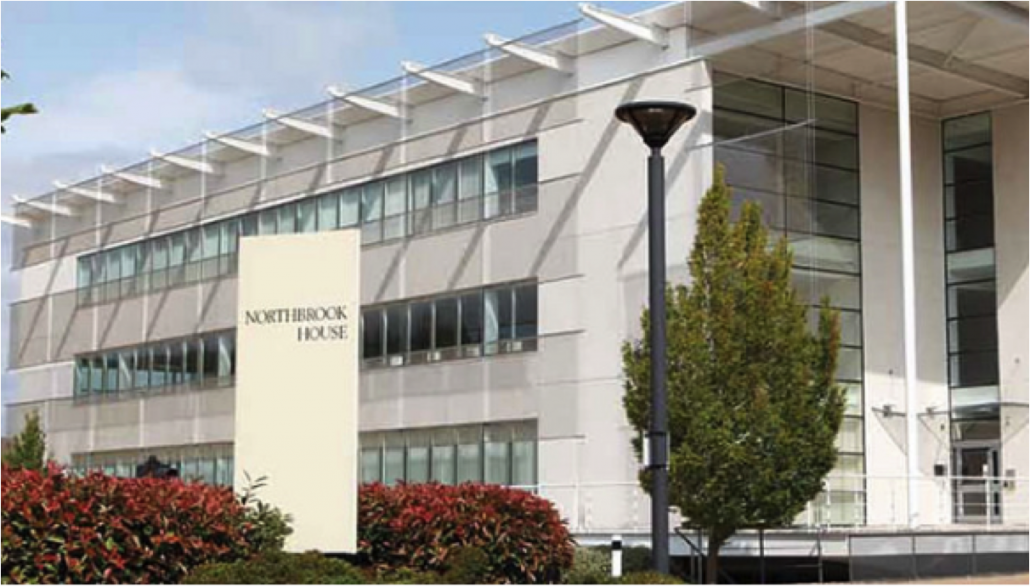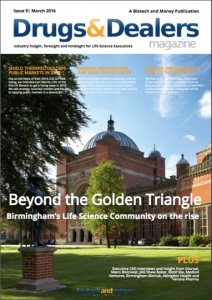Circassia Interview: 1 year on from IPO
In March 2014, Circassia took the title of London’s biggest biotech flotation for decades when the company raised £200m to develop their portfolio of anti-allergy drugs. Almost a year to the day of the IPO we caught up with Steve Harris, CEO of Circassia to find out just how transformational the first 12 months have been as a publicly listed company.
B&M: The last 12 months have been a very positive and transformational time for Circassia. Let’s start by reviewing the progress made over the last year.
SH: You can see from the results we announced two weeks ago that we’ve made strong progress across all of our four lead programmes. Our Cat-SPIRE Phase 3 study is fully recruited, and it’s a very large study in over 1400 patients. That study will report out in the first half of next year.
In our house dust mite allergy programme we have now started a large Phase 2 field study with around 660 subjects. That study is being recruited as we speak and it’s on track. The Grass-SPIRE data we produced during the year showed we could give a short course of our product and 3 grass seasons later we still see an effect without any further treatment. So it’s pretty dramatic. We’re now gearing up to start a Phase 3 study in the first half of next year. We’ll set up 150 sites in 10 or so countries before we begin recruiting patients.
So that’s what we’ve been doing this year on those products. For our ragweed allergy treatment we are following patients up for a 2nd ragweed season with no further treatment. We will also be doing a larger phase 2 dose ranging study at the start of next year, looking at approximately 500 patients.
B&M: If we also look at the progress made in the commercialisation of the business. Are you able to outline what has been achieved.
SH: We recruited our Chief Commercial Officer, she started in September. What we need to do is educate the physicians as to our technology, how it works, and the data available. You can’t sell the product because it’s not approved yet, but you can educate the market. And we are currently recruiting the people to enable us to carry out that education process. Half of the team will be US based and half in Europe. And because reimbursement is absolutely critical these days, we will also be hiring market access experts for this process, again US and Europe based.
So we’re starting on that process now. It’s quite an undertaking for a company of our size to do that. But if you don’t, you won’t get the launch you need. We raised sufficient money at the IPO to allow us to do this and post our Phase 3 results we will multiply that resource by some considerable number.
B&M: Do you think that the sheer scale of the allergy market is going to help with the conversations you have with payers and reimbursers?
SH: I think it will help the conversations. Importantly, we’re focused on the moderate to severely allergic patients. Those are the people that are very poorly served. When you look at the data allergy is the biggest cause of lost productivity at work in the US, bar anything else, by a long way. I think allergy is sometimes underestimated in terms of the impact it has on society, it’s absolutely huge. I think that is why people will pay for effective treatments.
Patients are incredibly motivated. I’m sure you know people who are moderately to severely allergic, and if you ask them what they’d do to get better they’d tell you it’s a lot.
B&M: You mentioned that the US market holds the greatest potential for Circassia. How will you be looking to exploit that opportunity?
SH: There are 3500 practising allergists in the US. We will be setting up a direct sales force. We raised sufficient funds at the IPO to set up the commercial operations, to hire the medical liaison officers, to hire the sales force and to put in place the infrastructure necessary, and that’s what we’ll be doing. A sales force of no more than 100 is well within our capabilities and that’s sufficient to address that market.
B&M: Beyond Europe and North America, is Asia a target market?
SH: It absolutely is, but it’s not something we would do ourselves. In Japan for example, we’d look for partners. We are not in the process of looking for partners now as we are waiting until we have begun the clinical development of our Japanese Cedar allergy treatment, which is very important in the Japanese market. 50% of the population are sensitive to Japanese Cedar pollen so a Japanese Cedar product has huge potential. We’re currently in the process of identifying the epitopes that go into that product, and we’ve nearly finished that process. We are talking to the Japanese regulators about the toxicology work they want us to do, and later in the year we’ll be talking about the development programme. Once we’ve done that we’ll then be in good shape to talk to partners.
B&M: What do you think is the biggest threat to the business at the moment?
SH: For a company progressing as rapidly as Circassia there are a number of areas to keep on top of, and of course you can always be surprised. Recruiting the right people, scaling up our commercial capabilities and managing multiple late-stage programmes can be challenging, but fortunately we’ve a great team in place to address this. In addition, it goes without saying that as a company still in clinical development there’s always an associated risk. To manage that risk, particularly for our lead product, we’ve made sure we’ve designed our phase III study as well as we possibly can. We’ve been very cautious in how we’ve powered the study, so if anything it’s overpowered as we’ve assumed the treatment effect will be lower and the variability greater than we’ve seen in phase 2. We’ve also been very selective in the patients recruited to the study to make sure they are properly allergic and have significant symptoms so you can show the difference with treatment.
B&M: We recently spoke to Dr Jim Phillips at Midatech Pharma and he spoke of his ambition to build a £3 billion company. What are your ambitions for Circassia?
SH: Our ambition is to build a self-sustaining speciality pharma business that develops that sells its own products. Part of that could be supplemented by acquisitions if they made sense at the time. But that’s our ambition.
You can see a number of companies that have trodden that path before, and have been extremely successful. You can set a target like $3 billion, but you have to say by when. I want to rapidly build a self-sustaining speciality pharma business as quickly as I can. I want to be able to control our own destiny. I think you do that by commercialising your own products. I don’t want to rely on partners to do those things. Partners can help, but I think you should be the driving force behind your own products. So we’re very ambitious, we want to build a very large company. We think any one of our products can sell more than half a billion dollars, and that’s a lot of money. If you’ve got 1 product selling half a billion dollars, you’ll be a $3 billion dollar company. That’s the sort of multiples or greater you would expect. If we get 4 products on the market selling anything like that, we’ll be 4, 5, 6 times the size of that. That’s the scale of our ambition.
B&M: You mentioned acquisitions. Do I understand that acquisitions are not a major part of your cause or strategy?
SH: It is part of our strategy, and we have talked to shareholders about that. What we want to build is a broad base speciality pharma business. To do that we want to deliver our pipeline and to commercialise our own products. But we also want to broaden out the pipeline and the commercial products we might sell. We’re not promising we’ll do that next week or next month because these things are difficult to do, especially in terms of identifying the right things that are complementary with our business, and paying the right price for them. But what we’ve flagged is if there are opportunities to do that, we absolutely will.
B&M: Last year’s IPO was the UK’s largest for decades. Did you feel that added unforseen pressure?
SH: Well, there is more pressure just because we’re higher profile. But I really don’t think about it like that. I just think about the fact we’ve got a job to do. Frankly it doesn’t matter if you’re private or public. You have to deliver for your shareholders. For me that’s the most important thing.
The only additional consideration is you obviously do a lot more investor meetings in the City, updating analysts, press, shareholders, and potential shareholders. And that just takes more time than you would ever spend as a private company. But I guess I don’t really feel additional pressure in any other sense.
I suppose one thing that has surprised me is how much profile the IPO has given us, even across the Atlantic in the US. The biotech market over there is incredible, and although there’s a huge number of companies I would say everyone we speak to has heard of us because we’ve managed to get that profile. That’s actually very helpful. It allows us to engage potential investors in the US, institutional investors, where maybe they wouldn’t have listened to a UK based company normally.
B&M: What have you learned from dealing with investors in your time as CEO?
SH: Investors are people at the end of the day. What they want to do fundamentally is understand what you do. They want to understand that if it’s successful you can make a lot of money, and that you’ve got a credible plan to achieve that, and can give them confidence you can execute it. At the end of the day if we do well, and we do what we say we’ll do, they will do very well.
Fundamentally, I think they want to be able to trust you.
B&M: What do you think resonated the most with your investors?
SH: I think everybody knows someone who suffers from significant allergies. So investors can put themselves in the place of that person, and consider what would they do, and they get it.
With some of the rare diseases, as awful as they are, they’re quite difficult to picture and understand what it means. But you can really understand allergy because it’s your sister, your mother, your friend, and they can’t go out in the summer, or they can’t visit friends because they’ve got a cat. There’s all sorts of things you can’t do if you’ve got allergies. Can you imagine not being able to go out in the summer? You want to go out but you can’t because it makes you feel so awful.
B&M: If we look at the life science industry in the UK as a whole. What do you think needs to happen for investment to fundamentally grow?
SH: I think success always breeds success. When investors see other investors making money, they become more interested. I think that’s just a natural consequence. I think what people tend to forget are some of the successes of the past and they have historically focused on the failures. They say company A or B is very risky because they had a bad time maybe in 2000 or a few years ago. But I think what they also forget is that if you had invested across the board in say Shire, CAT, Celltech you’d have done extremely well.
More recently you look at SkyePharma, Vectura, Vernalis and BTG, they’ve been good investments over recent times. So it’s easy to remember the failures and forget the successes. I think if you’d looked across the board, you’d probably only have to have invested in Shire in 1997 when it was worth £150 million to make every penny back and a lot more from the investments in the other less successful companies.
It’s important to put the past in perspective to give people some balance and confidence. It’s also important the industry has some successes going forward which will also give confidence. There has definitely been a change recently with more people at least willing to listen to investment stories now than a year or two years ago.
There were certain investors where you’d try to get in and they’d say they’re not interested. Now some of those will actually want to hear what you have to say. It’s a slow change, but it is changing. Of course the biggest change will come when people make lots of money.
B&M: What do you think you can do as a CEO to influence this?
SH: I’m sure there are many people that can collectively make a difference. Anyone on their own can only make an incremental difference. But I think perhaps presenting the facts of the number of historic successes and how successful they have been versus the failures is important. It’s about all of us educating the market. The market shouldn’t be taking rash decisions, but they should be taking well educated decisions.
B&M: To close, what advice would you give to a CEO embarking on their first 12 months as a Plc?
SH: I think if you’ve done it before you know what to expect. If you haven’t, what comes as a surprise perhaps is the amount of time you have to spend in the City.
Consequently you have to put in place the right team to allow you to spend that time in the City, otherwise you just don’t have the time to do a decent job.
You do need to keep the news flow and the information flow coming to all interested parties, whether it’s existing shareholders, potential shareholders, analysts, press and so forth. It’s not a trivial exercise. That can come as a shock. But you just have to structure yourself internally in a way that allows you to do that.
Circassia’s interview was one of 3 interviews focused on IPOs in March’s Drugs & Dealers Magazine. Read interviews with Dr Darrin Disley, CEO of Horizon Discovery Group and Dr Jim Phillips, CEO of Midatech Pharma, plus much more.





Leave a comment